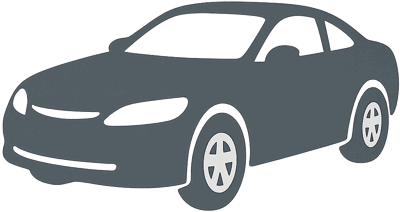 1992 Ferrari 512 TR Dimensions, Size & Specs
1992 Ferrari 512 TR Dimensions, Size & SpecsMeasurements of the 1992 Ferrari 512 TR, engineered for optimal performance and comfort
| Dimensions | |
|---|---|
| Length: | 4480 mm176.4 in14.7 ft |
| Width: | 1975 mm77.8 in6.5 ft |
| Height: | 1135 mm44.7 in3.7 ft |
| Weight Specifications | |
| Curb Weight: | 1590 kg3505 lbs |
| Tire Specifications | |
| Tire Size: |
|
The Ferrari Testarossa 512 TR, produced from 1992 to 1994, is an iconic Italian sports coupe that continues the legacy of the famous Testarossa line. This generation featured refined styling and engineering enhancements that improved performance and handling. The 512 TR measures 4480 millimeters (176.4 inches) in length, making it compact yet aggressive in stance. Its width is a striking 1975 millimeters (77.8 inches), contributing to its wide and planted road presence. Standing just 1135 millimeters (44.7 inches) tall, the 512 TR maintains a low, aerodynamic profile typical of Ferraris from this era. Weighing in at 1590 kilograms (3507 pounds) curb weight, this model balances lightweight construction with the robust powertrain it houses. The tires fitted on the 512 TR are sized at 295/35 ZR18, offering superior grip and stability essential for a high-performance sports car. Collectively, these dimensions and features highlight the 512 TR's blend of sleek design, powerful performance, and aerodynamic efficiency, making it a revered model in Ferrari's lineup during the early 1990s.
Discover the standout features that make the 1992 Ferrari 512 TR a leader in its class
Have a question? Please check our knowledgebase first.
The Ferrari Testarossa 512 TR measures 4480 mm (176.4 inches) in length, 1975 mm (77.8 inches) in width, and 1135 mm (44.7 inches) in height. These dimensions emphasize its low-slung, wide stance typical of a high-performance coupe designed for aerodynamic efficiency and a striking road presence.
The curb weight of the Ferrari Testarossa 512 TR is 1590 kg (3507 lbs). This relatively moderate weight for a powerful supercar helps balance performance and handling. The combination of a lightweight chassis and a potent engine ensures agile maneuverability and quick acceleration, contributing to the car's legendary driving dynamics.
With a length of 4480 mm (176.4 inches) and a width of 1975 mm (77.8 inches), the Ferrari Testarossa 512 TR will typically fit into a standard residential garage, which usually measures around 2440 mm (96 inches) wide and 6100 mm (240 inches) deep. However, its width is quite close to standard garage widths, so careful parking is advised. The low height of 1135 mm (44.7 inches) is not a concern for garage clearance.
At 1975 mm (77.8 inches) wide, the Ferrari Testarossa 512 TR is notably wider than many contemporaries such as the Lamborghini Diablo, which is about 2037 mm (80.2 inches), and the Porsche 911 Turbo of that era, which measured around 1745 mm (68.7 inches). The Testarossa’s wide stance enhances road grip, stability at high speeds, and contributes to its aggressive styling.
The Ferrari Testarossa 512 TR is equipped with tires sized 295/35 ZR18. This means the tires are relatively wide, enhancing grip and cornering capabilities. The 18-inch diameter supports larger brake discs for improved stopping power. Such tires are crucial for a high-performance car, ensuring optimal traction and responsiveness at high speeds.
The low height of 1135 mm (44.7 inches) significantly reduces aerodynamic drag, which improves high-speed stability and fuel efficiency. A lower center of gravity also enhances cornering performance and vehicle responsiveness. The sleek height design defines the Testarossa’s classic sports car silhouette, contributing to both its aesthetic appeal and driving dynamics.
Compared to the original 1984 Ferrari Testarossa, the 512 TR saw slight dimensional changes that impacted handling and aesthetics. The 512 TR maintained a similar length around 4480 mm but featured a wider track for improved stability, reflected in its width of 1975 mm. The height remained comparably low at 1135 mm, sustaining the car’s sleek, aerodynamic profile. These subtle tweaks enhanced performance and driver engagement.
The Ferrari Testarossa 512 TR is a two-seat coupe focused on driver and passenger experience rather than passenger capacity. While precise interior dimensions aren't publicly emphasized, the low roofline and compact cockpit prioritize sporty ergonomics. Storage space is limited, typical for supercars, making it ideal for spirited drives rather than long trips with extensive luggage.
The Ferrari Testarossa 512 TR's curb weight of 1590 kg (3507 lbs) is competitive among early 1990s supercars. It is lighter than many contemporaries like the Lamborghini Diablo (around 1595-1640 kg) but heavier than smaller sportscars such as the Porsche 911 Turbo (approx. 1475 kg). This balance of weight and power was designed to provide optimal performance without compromising stability and control.
The Ferrari Testarossa 512 TR's dimensions, 4480 mm (176.4 inches) long and 1975 mm (77.8 inches) wide, are somewhat smaller compared to many modern Ferraris, which typically exceed 4600 mm in length and 2000 mm in width. Modern Ferraris often have more room for passengers and technology but maintain similar performance ethos with wider track widths and low heights for optimal aerodynamics and handling.
Discover similar sized cars.
| Production: | 1994-1996 |
|---|---|
| Model Year: | 1995 |
| Length: | 4480 mm176.4 in |
| Width: | 1976 mm77.8 in |
| Height: | 1135 mm44.7 in |
| Production: | 1984-1992 |
|---|---|
| Model Year: | 1985 |
| Length: | 4485 mm176.6 in |
| Width: | 1975 mm77.8 in |
| Height: | 1130 mm44.5 in |

| Production: | 2024-present |
|---|---|
| Model Year: | 2024 |
| Length: | 4490 mm176.8 in |
| Width: | 2000 mm78.7 in |
| Height: | 1140 mm44.9 in |
